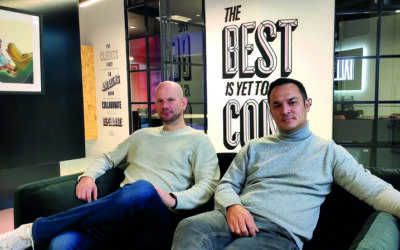Since 2020, far more of life and work has moved online, and isn’t going to move back. Nor is communication.
Trevor Pill, Executive Director of Newcastle-based specialist healthcare marketing communications agency Onyx Health, shares his thoughts on the future of digital communication in the sector, and why creativity is vital.
The last few years haven’t been easy. The global pandemic transformed our day-to-day lives and changed the way we communicate.
The endless talk of the “new normal” is often misleading, as this is only just starting to emerge now official COVID-19 restrictions have gone. We also need to remember that many of the changes, such as the greater importance of digital communication, are an acceleration of pre-existing trends.
However, a lot of communication activity has moved online during the pandemic, and it isn’t going to move back. That’s why developing digital content that stands out from the crowd is essential for the communication industry to get its clients seen and heard.
We need a creative revolution in digital communication to adapt to the reality of a post-pandemic world. Producing digital content with enhanced visual engagement will be an important part of making this happen.
Taking digital visuals to the next level
The increased competition in the digital space requires a creative visual response that goes beyond standard post images, hashtags and blurry camera videos. Getting an audience’s attention bombarded with digital content isn’t always easy. That’s why greater use of video and animation, alongside eye-catching visuals, is needed to develop more innovative digital content.
Video content can turbocharge audience engagement; the figures show that users spend more than twice as much time on pages with video content.
However, video content for its own sake won’t work. The audience needs to connect with your content, they need to be informed, engaged and entertained. This requires effective storytelling and a robust digital communication strategy.
This is particularly important in healthcare communications, when you are trying to grab the attention of a busy healthcare professional (HCP) in a matter of seconds, when they are scrolling through social media in between doing their day job.
Useful tactics can include using animated videos that take the audience on a journey, video testimonials from target consumers to give a human face to a brand, and educational explainer videos that make complex issues accessible.
We’ve recently seen innovations such as Nucleus PatientEd, a form of automated medical education software. It sends patients 3D animations of conditions and treatment options using a fusion of science, creativity and video technology. It presents complex medical concepts in a way that is dynamic, informative and fun to watch.
But video content isn’t the whole story. The latest developments in virtual and augmented reality can also be used to offer the audience something genuinely distinctive.
Virtual reality and augmented reality
Staying ahead of the competition often involves providing a different kind of digital experience. VR and AR techniques can provide audiences with a unique immersive experience that harnesses cutting-edge technology to enhance user engagement.
Virtual engagement experiences have become particularly important during the pandemic in healthcare and pharma communications to facilitate engagement with HCPs. While the official restrictions have now been removed, the virus hasn’t gone away, and access to HCPs is unlikely to return to pre-pandemic levels.
Major international healthcare symposiums such as the European Society of Cardiology Congress and European Atherosclerosis Society are no longer solely online, adopting a hybrid digital and face-to-face model.
The uncertainty of future new variants and remaining restrictions in certain countries suggests this is unlikely to change. Digital conferences may not replace face-to-face interaction, but they have become a normalised default option and will have a far greater role than before the pandemic.
Digital technology provides part of the solution to this new normality. It’s possible for all of the features of traditional offline engagement to be in an integrated virtual platform. This includes conference presentations, medical education, product demonstration, virtual advisory boards, and direct links to sales teams, providing a more direct, unmediated form of experience.
Unlike traditional limitations of conferences and event stands, it is possible to offer users a limitless digital space that users can continuously improve and develop, accessible worldwide with the potential to reach a global audience. This has the potential to transform the way we communicate beyond the pandemic.
Chatbots and digital dialogue
Chatbots, which use machine learning rules to generate automated responses through pattern recognition as an AI-driven alternative to face-to-face interaction, can generate interactive conversations and form part of building a relationship between businesses and target customers.
We’ve all seen versions of this on banking and retail websites to help customers access information. However, this technology is increasingly being used in healthcare-based communication settings.
Healthcare chatbots can fulfil various functions, including booking appointments, ordering prescriptions, checking symptoms, and providing basic medical information and advice. This function has increased markedly since the onset of the pandemic.
Babylon Health provides patients with an AI chatbot-based consultation service using their medical history and standardised medical knowledge to respond to their queries. Patients can initially report symptoms on an app, which is checked against an official medical database, using speech recognition technology. They will then receive a recommended course of action based on the information provided.
The success of their work led them to partner with the NHS to develop a digital triage system for referrals and dispensing health advice during the COVID-19 crisis.
In recognition of its growing importance, Health Education England has recently published the first roadmap on the use of AI across the NHS, with a specific focus on using the technology to improve communication and medical education with patients. Therefore, we can expect to see the increasing use of healthcare chatbots in years to come.
Whatever the future may hold for digital communications in healthcare, it’s clear that things will never be the same again in a post-pandemic world.
Creativity, innovation and a more integrated approach to digital strategy across different technology platforms will be essential for the communication industry to remain competitive. Off-the-shelf digital solutions need to be off the agenda.











